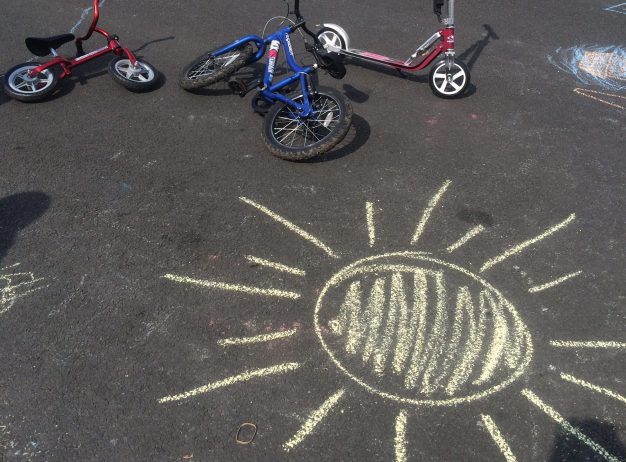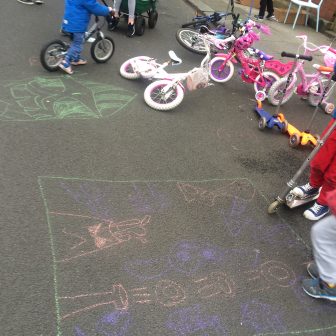
Street play and everyday relationships
Children are at the heart of the street play movement, but geographer and academic Alison Stenning, reporting here from the Play And Playwork conference in Leeds this week, also sees exciting research opportunities into its potential for building relationships across whole communities.
Earlier this week I spent a day in the play and playwork conference at Leeds Beckett University, my first play conference. I’ve been thinking more and more about play in the last year or so. Since December 2015, I’ve regularly coordinated with my neighbours to close my street for play about once a month, following the Playing Out model.
In the last few months, I’ve started working with two other local street organisers to develop and promote opportunities for street play across North Tyneside; and in the last few weeks I’ve realised that street play offers a fantastic opportunity to research the geographies of our everyday relationships, an idea that’s been central to my research and teaching for the last few years.
I love seeing kids play out in our street, I love the slightly subversive temporary displacement of cars, I love the chalk left on the street, often for days after we’ve been playing. But what I’m hoping to explore in my research is why adults plan street play, what they hope will happen, and what does happen, to them and their streets, as street play progresses.
Chalk on the street
 From the very start of the conference, the synergy between children playing and adult sociability was clear. Leeds’ Lord Mayor noted in her welcoming address that playing out is important not just for kids but for whole communities, as play builds relationships across diversity and difference, and as children’s presence in public space encourages – or even forces – adults to hang out outside too, watching their children, chatting with neighbours, and sometimes starting to play in their own ways too.
From the very start of the conference, the synergy between children playing and adult sociability was clear. Leeds’ Lord Mayor noted in her welcoming address that playing out is important not just for kids but for whole communities, as play builds relationships across diversity and difference, and as children’s presence in public space encourages – or even forces – adults to hang out outside too, watching their children, chatting with neighbours, and sometimes starting to play in their own ways too.
In the first workshop I attended, John McKendrick explored how we might make our cities and neighbourhoods play-friendly, and asked what it means for a place to be play-friendly, child-friendly or even family-friendly. What kinds of spaces do these different, if related, initiatives imagine?
The possibility of play is certainly at the heart of these visions, but so too is a broader idea of building relationships within communities, to draw people out into public spaces within their neighbourhoods, and to enable communities to develop shared identities and senses of belonging. The ‘play rhetorics‘ developed by Brian Sutton-Smith and cited by John might be augmented by an idea of play as relationships, as a catalyst for connection, friendship, recognition and community.
This movement is about kids playing out, but it is also about an idea of our streets and neighbourhoods as places of lively, hopeful, ordinary, everyday relationships.
This is an idea at the heart of street play, and of my experiences of and hopes for playing out in my street and elsewhere. It is also one recognised by Helen Forman in her contribution to the conference’s street play workshop. Reflecting on the kinds of residential spaces that encourage and enable play, Helen reported that most research on the topic documents an improvement in adult ‘hanging out’ and sociability in places where children play outside.
Children are clearly at the heart of street play. This movement is about kids playing out, but it is also about an idea of our streets and neighbourhoods as spaces that enable and reflect lively, hopeful, ordinary, everyday relationships. We can perhaps re-imagine play-friendly, child-friendly and family-friendly streets as relationship-friendly, streets that help us make and sustain connections, which enable us to feel recognised, known and at home.
It is these ideas that I’m hoping to explore, using ideas not only from literatures on play, children’s geographies, and communities, but also from theorisations of relationships, especially those that are part of and inspired by Donald Winnicott (for whom play itself was extraordinarily important) and the British object relations school. These thinkers imagine, in different ways, that our relationships, with intimate and imagined others, create the environment within which we find ways of going on being. This is the start of the idea that I hope to
work with to explore and understand street play and everyday relationships.
Alison Stenning
Photos: Alison Stenning
This piece was first published at researchingrelationships




